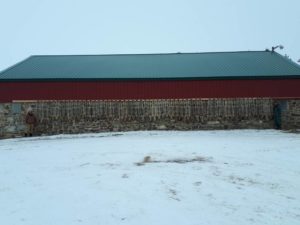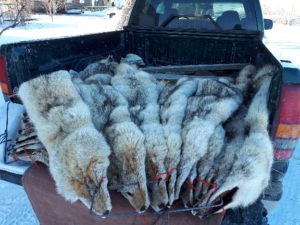Cam Cook’s Coyote Adventures
By Glen Wunderlich
Cam Cook is a sportsman. He lives in southern Alberta, Canada, some 20 miles north of the Montana border and got his first trapper’s license over 40 years ago. Cam credits his father for nurturing his love of the outdoors and for having taken him hunting at a young age. Cam, with four grown children is married to a most understanding and supportive lady, who’s not afraid of pitching in on the trap line when necessary and stands watch for grizzly bears and cougars, while Cam heads in for a check.
Cam estimates he’s taken over 1500 coyotes during his lifetime and that figure includes a fair amount shot with his Tikka rifle in .22-250 caliber.

Cam Cook’s pelts ready for market
Interestingly, he got serious about snaring only four years ago, and in the process has sent 225 coyotes to the fur market since. These are not the scrawny type of coyotes we have here in Michigan, but by all accounts are graded the best in the world by fur buyers. Last year alone Cam sold 98 coyotes for an average of $149 (Canadian) each and he earned every penny!

One day’s catch of prime fur
His method of snaring involves bait piles of road-killed deer obtained from the Department of Highways and game wardens. Up to 40 homemade snares are placed strategically along nearby trails but never within 50 feet of bait for fear of catching his most destructive competitors: golden eagles. Although Cam diligently checks his sites every other day, sometimes it’s not soon enough. He states that eagles prefer fresh, warm coyotes more than cold, frozen roadkill and will render his catches worthless in short order.
While Cam’s catch numbers may seem staggering, this season’s take has been only about one third of last year’s. The primary reason for the reduced catch rate has been warm weather. He states, “During warm weather, coyotes don’t need my bait sites; they have lots of mice to catch, as well as jack rabbits.” Other hunters and trappers have gotten into the action and are most certainly part of the equation, as well.
“I believe coyotes need managing when population densities get too high”, says Cam. “Disease does this naturally and a valuable and beautiful resource is lost. Few sights in nature are as disgusting and revolting as a coyote in full onset of mange. I don’t know how the poor creatures survive when the temperature gets below zero and they virtually have to keep moving just to stay alive. Last year I harvested 10 of them in various stages of mange and the hide is of no commercial value at all; I am only relieving these animals of suffering and a painful end.”
He also mentions that coyotes are major contributors to fawn mortality – particularly antelope. “It is very rare now to see a pair of twins with a doe anymore. The antelope had moved in close to dwellings and farmsteads in hopes of staying away from the coyotes – especially at lambing time. With the control that we’ve been trying on the coyotes, we are seeing a few more antelope now.”
He advises any up-and-coming young trapper to take a trapping course and to join their local trappers association. It is wise to contact known trappers and snare men and pick their brains for any tips and knowledge that they are willing to share; plus, the internet and YouTube are your friends.
Michigan has its own trapping and snaring rules and they may be quite different than those elsewhere, so brush up on them before assuming anything. You’ll need a small game license that comes with the requisite base license plus a fur takers license. For Michigan-specific supplies and help, F&T Fur Harvester’s Trading Post in Alpena is a good resource at 989-727-8727 or www.fntpost.com.
Now is the best time for either hunting or trapping coyotes, because they are extremely active during the mating season and will roam many miles in one day. I know one thing: My pal, Joe and I will be targeting a certain song dog that haunted me during deer season – pelt or no pelt.

 The super accurate Varmint X lineup will initially feature offerings in four of the most popular centerfire rifle calibers for predator hunting: .204 Ruger, .223 Rem, .22-250 Rem and .243 Win. The charcoal-colored, polymer-tipped bullets in each caliber are optimized for long-distance accuracy and explosive impact on coyotes, prairie dogs and other varmints. “Predator hunting is on the rise and
The super accurate Varmint X lineup will initially feature offerings in four of the most popular centerfire rifle calibers for predator hunting: .204 Ruger, .223 Rem, .22-250 Rem and .243 Win. The charcoal-colored, polymer-tipped bullets in each caliber are optimized for long-distance accuracy and explosive impact on coyotes, prairie dogs and other varmints. “Predator hunting is on the rise and